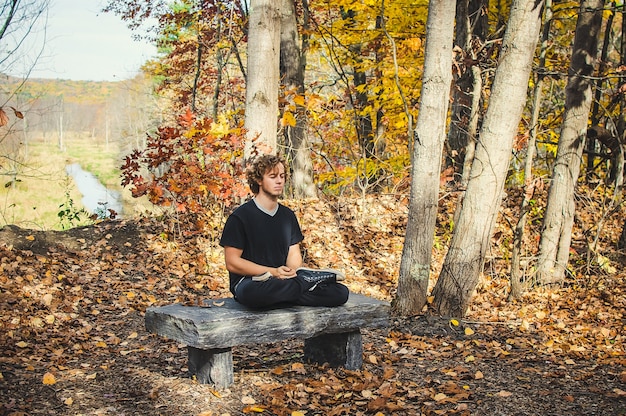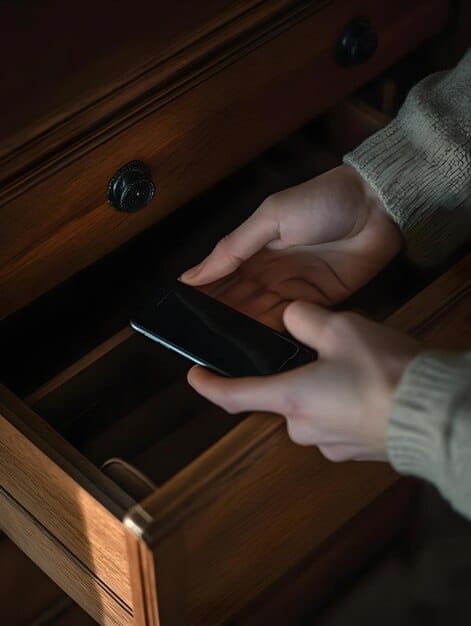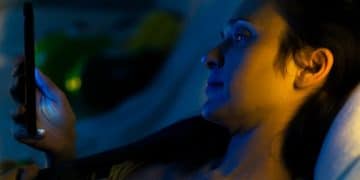Social Media Detox: Reduce Stress with a 4-Day Digital Break

Are Social Media Notifications Increasing Your Stress? A 4-Day Digital Detox Guide: This guide provides a structured approach to reducing stress by minimizing social media use, offering a step-by-step plan to disconnect and regain control over your mental well-being.
Are social media notifications increasing your stress? A 4-Day Digital Detox Guide offers a roadmap to reclaim your peace of mind. Constant alerts and updates can be overwhelming, but a short, focused break can make a significant difference.
Understanding the Impact of Social Media on Stress
Social media has become an integral part of modern life, but its constant presence can contribute to increased stress levels. Recognizing the impact of these platforms is the first step toward managing their influence on your mental health.
The relentless stream of notifications, comparisons, and updates can trigger a cascade of stress responses. Understanding these triggers will empower you to take control and prioritize your well-being.
The Science Behind Social Media Stress
Social media platforms are designed to be addictive, utilizing psychological principles to keep users engaged. This constant engagement can lead to a state of chronic stress.
Dopamine, a neurotransmitter associated with pleasure and reward, is released when we receive likes, comments, or new notifications. This creates a feedback loop, encouraging us to constantly check our phones and seek validation online.
Studies have shown that excessive social media use is correlated with higher levels of anxiety and depression. The pressure to maintain a perfect online persona and the fear of missing out (FOMO) can significantly impact mental well-being.
- The never-ending cycle of notifications keeps the brain on high alert.
- Comparing yourself to others online can lead to feelings of inadequacy and low self-esteem.
- The fear of missing out (FOMO) drives compulsive checking behavior.

Identifying Your Social Media Stress Triggers
Everyone experiences social media differently, so it’s crucial to identify your personal triggers. These triggers can be specific platforms, types of content, or even certain individuals you follow.
Reflect on your social media usage and note any patterns. Do you feel anxious after spending time on Instagram? Does scrolling through LinkedIn make you feel inadequate? Identifying these triggers allows you to create a more tailored digital detox plan. Pay attention to physical symptoms of stress, like muscle tension and headaches after social media use.
Consider tracking your mood before and after using social media. This can provide valuable insights into the impact of these platforms on your overall well-being.
Understanding the science behind social media stress and identifying your personal triggers are essential for creating an effective digital detox plan. This awareness empowers you to take control of your mental health and establish healthier relationships with technology.
Preparing for Your 4-Day Digital Detox
Successfully completing a 4-day digital detox requires planning and preparation. By setting clear goals and strategies, you can minimize distractions and maximize the benefits of your time offline.
This preparation will not only increase your chances of success but also help you develop a more mindful and intentional approach to technology in the long run.
Setting Realistic Goals
Before starting your digital detox, define what you hope to achieve. Are you aiming to reduce stress, improve sleep, or reconnect with offline activities?
Setting realistic goals will help you stay motivated and focused throughout the detox. Avoid setting overly ambitious targets that may lead to discouragement. Start small and celebrate your progress along the way.
Consider what aspects of your digital life are most stressful. Perhaps you want to limit your time on specific platforms or reduce the frequency of checking notifications.
Write down your goals and keep them visible as a reminder of your intentions. Regularly revisit these goals to track your progress and make adjustments as needed.
Informing Your Network
Let your friends, family, and colleagues know that you’ll be unavailable online for a few days. This will prevent misunderstandings and ensure that important communications are handled appropriately.
Send a brief message explaining your intention to disconnect and provide alternative contact information for urgent matters. You might also consider setting up an auto-reply on your email account.
- Avoid feeling pressured to respond to messages immediately.
- Preemptively communicate your absence, managing expectations.
- Inform close contacts about alternative ways to reach you if necessary.
Creating an Alternative Activities List
One of the biggest challenges of a digital detox is filling the time that would normally be spent online. Prepare a list of alternative activities that you enjoy and find fulfilling.
This list might include reading, exercising, spending time in nature, pursuing a hobby, or connecting with loved ones. Having a variety of options will help you avoid boredom and stay engaged during your detox.
Explore activities that you haven’t tried before. This is an opportunity to rediscover old passions or develop new interests separate from the digital world.
Gathering supplies and resources for your alternative activities in advance will help you dive right in throughout the detox when the time comes.
By setting specific goals, informing your network, and creating an alternative activities list, you are paving the way for a successful and rewarding digital detox. These preparations will help you stay focused, engaged, and connected to the world around you.
Day 1: Disconnecting from Social Media
The first day of your digital detox is all about making the initial break from social media. This can be the most challenging day, as you’re likely to experience cravings and urges to check your phone.
By implementing specific strategies and focusing on alternative activities, you can successfully navigate these challenges and begin to experience the benefits of being offline.
Turning Off Notifications
The first step is to disable all social media notifications on your phone and computer. This will eliminate the constant stream of alerts that trigger the urge to check your accounts.
Go to your phone’s settings and disable notifications for each social media app individually. You can also customize notification settings to allow only certain types of alerts, such as direct messages from close contacts.
Consider turning off all notifications, including emails and other non-essential alerts. This will help you create a more peaceful and distraction-free environment.
Removing Social Media Apps
If you find it difficult to resist the temptation to check social media, consider temporarily removing the apps from your phone. This will add an extra layer of friction and make it less convenient to access your accounts.
Deleting the apps can feel liberating and empower you to break free from the habit of compulsive checking. Remember, this is a temporary measure, and you can always reinstall the apps later if you choose to do so.
You might instead choose to move all social media apps into a single folder and hide it on a less accessible phone screen. This acts as a visual reminder from opening the apps on rote by accident.
Engaging in Offline Activities
Fill your day with activities that you enjoy and find fulfilling. This will help you stay distracted from social media and focus on the present moment. Refer to the alternative activities list you created during the preparation phase.
Consider spending time in nature, reading a book, exercising, or pursuing a hobby. Connecting with loved ones in person can also be a great way to spend your time offline. Engage in activities that bring you joy and help you relax. Whether it’s doing puzzles, going on a nature walk, or cooking a new recipe, ensure your day is filled with things you love.
- Plan engaging activities to occupy your time.
- Prioritize experiences in nature, which helps alleviate stress and anxiety.
- Connect with friends and family to reinforce your social life outside of social media.

The first day of your digital detox sets the tone for the rest of the week. By turning off notifications, removing social media apps, and engaging in offline activities, you can successfully disconnect and begin to experience the benefits of a less digital life. Remember to be patient with yourself and celebrate your progress along the way.
Day 2-4: Managing Cravings and Reconnecting
Days 2 through 4 of your digital detox are focused on maintaining your commitment and deepening your connection with the offline world. You’ll likely experience fewer cravings as time passes, but it’s essential to have strategies in place to manage any remaining urges.
These days are also an opportunity to reflect on your relationship with social media and consider how you want to reintroduce it into your life after the detox.
Dealing with Withdrawal Symptoms
As you spend more time away from social media, you may experience withdrawal symptoms such as boredom, anxiety, or irritability. These symptoms are normal and temporary, and there are several ways to manage them.
When you feel the urge to check social media, take a deep breath and remind yourself of your goals for the detox. Distract yourself with an alternative activity or connect with a friend or family member.
Mindfulness techniques can be particularly helpful in managing cravings. Focus on your breath, your surroundings, or a specific sensation in your body. This will help you stay grounded in the present moment and avoid getting caught up in your thoughts.
Mindful Technology Use
Even though you’re on a digital detox, it’s important to use technology mindfully when necessary. For example, if you need to use your phone for navigation or communication, do so intentionally and avoid getting sidetracked by social media or other distractions.
Set clear boundaries for your technology use and stick to them. Avoid multitasking and focus on one task at a time. This will help you stay present and avoid feeling overwhelmed.
Reflection and Re-Evaluation
Use this time away from social media to reflect on your relationship with these platforms. Ask yourself questions like:
- How does social media make me feel?
- What are the benefits and drawbacks of using social media?
- How can I use social media in a more intentional and healthy way?
Consider implementing new boundaries and habits when you reintroduce social media into your life. This might include limiting your time on specific platforms, unfollowing accounts that make you feel bad, or prioritizing real-life connections over online interactions.
By dealing with withdrawal symptoms, practicing mindful technology use, and reflecting on your relationship with social media, you can successfully complete your digital detox and develop a healthier approach to technology in the future.
Reintroducing Social Media: Setting Boundaries
After completing your digital detox, it’s essential to reintroduce social media into your life in a way that aligns with your values and priorities. This involves setting clear boundaries and developing healthy habits that prevent you from falling back into old patterns.
This process is about reclaiming control over your digital life and using social media in a way that enhances, rather than detracts from, your overall well-being.
Time Limits
Set daily or weekly time limits for social media use. This will help you prevent excessive scrolling and ensure that you’re spending your time on activities that are more meaningful to you.
Use phone apps to track your usage and set alerts when you’ve reached your limit. Start with a realistic limit, like 30 minutes a day, and adjust the time until you find what works best with your routine.
Turn off auto-play features and resist the urge to binge-watch videos or scroll through endless feeds. Be intentional about when and how you use social media.
Curating Your Feed
Unfollow accounts that make you feel bad about yourself or trigger negative emotions. Focus on following accounts that inspire, educate, or uplift you.
Remove any connections or accounts that contribute to stress or feelings of inadequacy. Regularly evaluate your feed to ensure that it aligns with your goals and values.
Consider unfollowing influencers or any other content creators that provoke feelings of jealousy. Follow accounts that showcase reality and promote body positivity.
Being mindful about the content you consume directly influences your mood and outlook. Focus on content that helps you become a better version of yourself.
Prioritizing Real-Life Connections
Make a conscious effort to prioritize real-life connections over online interactions. Spend time with loved ones, engage in face-to-face conversations, and participate in activities that bring you joy.
Use social media to enhance your real-life relationships, not replace them. Share photos and updates with friends and family, but don’t let it become a substitute for meaningful interactions.
Schedule regular get-togethers with friends and family, and make a point of being present and engaged during these interactions.
By setting time limits, curating your feed, and prioritizing real-life connections, you can reintroduce social media into your life in a healthy and sustainable way. This will allow you to enjoy the benefits of these platforms without compromising your mental well-being.
| Key Point | Brief Description |
|---|---|
| 📱 Identify Stress Triggers | Recognize specific social media platforms or content that cause stress. |
| 📵 Digital Detox Prep | Inform your contacts, set clear goals, and list alternative activities. |
| 🚫 Day 1 – Disconnect | Turn off notifications, remove apps, and fill time with offline activities. |
| ✅ Reintroduce Mindfully | Set time limits, curate your feed, and focus on real-life connections. |
FAQ
▼
A digital detox is a period where you intentionally reduce or abstain from using digital devices such as smartphones, tablets, and social media. The goal is to alleviate stress and reconnect with the physical world.
▼
Start by setting realistic goals, informing your network, and creating a list of alternative activities. This preparation will help you manage cravings, minimize distractions, and ensure a successful digital detox.
▼
When the desire to use social media arises, distract yourself with an alternative activity like reading, exercising, or spending time in nature. Remind yourself of the reasons why you started the detox as well.
▼
You can make your social media feed less stressful by curating the content you see. Unfollow accounts that trigger negative emotions. Instead, follow accounts that inspire, educate, or uplift you.
▼
A social media detox can reduce stress, improve sleep, and enhance focus and productivity. It also allows you to reconnect with real-life activities and improve face-to-face communication skills.
Conclusion
Taking a 4-day digital detox is a powerful step toward managing stress and reclaiming control over your mental well-being. By understanding the impact of social media, preparing effectively, and setting healthy boundaries, you can create a more balanced and fulfilling life, both online and off.





